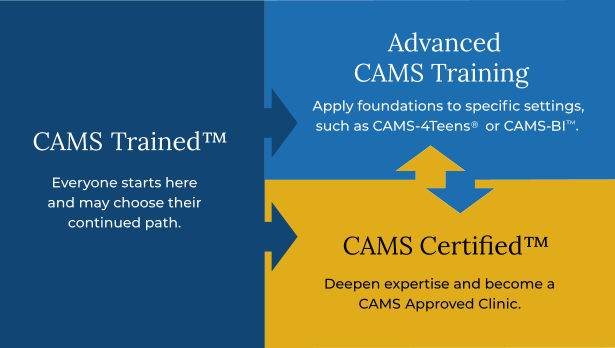Learn how the CAMS Framework® can support staff at correctional facilities in helping incarcerated individuals who are struggling with serious thoughts of suicide.
Training is available for:
- Correctional officers
- Supervisors
- Social workers
- Case managers
- Mental health clinicians
Everyone Deserves a Chance
Suicide is the leading cause of death in local jails in the U.S.,1 and it’s been a growing concern. From 2001 to 2019, the number of suicides increased by 85% in state prisons, 61% in federal prisons, and 13% in local jails.2 Correctional facilities have a primary focus on containment rather than on providing care. As a result, they often lack the necessary resources to effectively treat individuals who are struggling.
Clinicians and mental health professionals face many challenges in correctional facilities. They need a solution that works within their limitations. Frequent transfers and short terms are common. This makes it difficult for clinicians to accurately identify patients who are truly at risk. As a result, providing effective treatment becomes challenging. Clinicians need to know that the work they’re doing is effective in the short term while having lasting effects. There is where CAMS can be extremely beneficial.
How CAMS Can Help
CAMS is an evidence-based, suicide-focused solution that helps clinicians accurately gauge suicide risk while providing a clear path forward for treatment. CAMS guides providers and individuals to work together as collaborators. They dig deep into the unique experiences and background of the person struggling. The goal is to build a bridge between their trauma and suicidal ideation. It allows those at risk to feel heard in a safe and judgement-free dynamic. It also enables clinicians to more deeply understand the individual who suffers.
Benefits of CAMS for Correctional Facilities
Adaptable Framework
Because CAMS is centered around the individual and their experiences, it can be implemented into a variety of settings and work with diverse populations.
Quick Impact
CAMS engages individuals immediately by helping them identify suicidal drivers and equipping them with a plan for treatment. Research shows that the assessment experience in CAMS is therapeutic, which means that even with one session (CAMS Brief Intervention) can make an impact.
Shared Language
When CAMS is used within a system of care, it creates a shared language for providers. This enables each provider to work more effectively with the patient as they move forward. It helps ensure that the patient is getting the best care possible at each stage of their treatment journey.
A Clear Path Forward for Individuals
Recovery is always the end goal. Training correctional facilities staff in suicide treatment with CAMS is beneficial. It helps individuals who are struggling by providing a clear and direct path for optimal treatment. This approach decreases their suicidal suffering.
How CAMS Training Works
CAMS offers clinical suicide treatment training for those who are working with incarcerated individuals. We recommend that providers first become CAMS Trained™. After receiving the CAMS Trained designation, you and your team can enroll in Advanced CAMS training programs that take your CAMS knowledge further. During live training sessions, your correctional facility’s staff can hear directly from experts. These experts have experience working in the corrections field. They help guide your training to apply to the unique challenges of your facility.

As a clinician who has lost a loved one to suicide, I can vouch for CAMS being not only instructive but also personally healing in helping me feel like I CAN help people who think of suicide.
Evan Merida, MA, LPC, NCC
Sun and Shade Counseling, Denver, CO
The approach of sitting with a client’s thoughts of self harm without immediately jumping to hospitalization has led to better outcomes — both because I’m more confident to stay in that space with them and because that willingness creates a greater trust between us.
CAMS Trained Clinician
Frequently Asked Questions
Correctional professionals can prevent suicide by recognizing warning signs, fostering open communication, and using structured interventions designed for high-risk settings. Evidence-based approaches like the CAMS Framework® provide practical tools for assessing risk, engaging individuals in care, and creating collaborative safety plans.
Prisons reduce suicide risk through staff training, routine screening, safe housing practices, and timely access to mental health care. Programs that move beyond observation to active treatment—like CAMS—help incarcerated people feel heard and supported, addressing the drivers of suicidal thoughts rather than only the behaviors.
Common risk factors include isolation, loss of freedom, shame, untreated mental health conditions, and histories of trauma or substance use. Suicide is one of the leading causes of death in jails and prisons, which makes structured, evidence-based intervention critical.
The most effective help comes through collaborative treatment that validates the person’s experience and creates concrete steps for staying safe. The CAMS Framework® engages incarcerated individuals directly, giving them a voice in their own care while addressing both immediate risk and long-term drivers of suicidal thoughts.